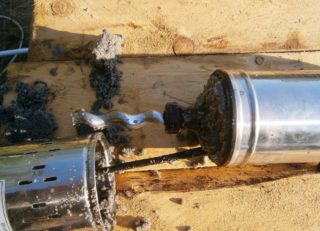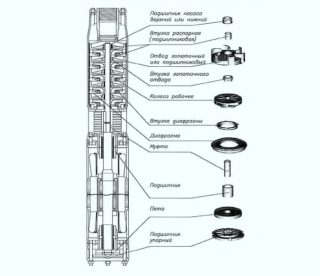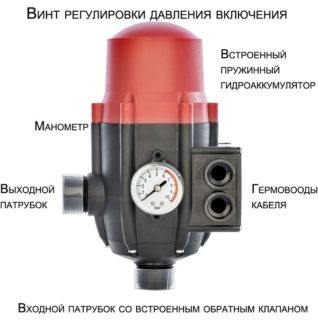A well on a personal plot allows free access to water, regardless of the presence of centralized networks. However, the rise of water requires the installation of pumping equipment and, as a result, audits with the replacement of worn parts. Therefore, it is important to know how to repair a submersible pump for a well or do it yourself.
The main types and causes of breakdowns

It is impossible to name a critical date after which the device may fail. The technical documentation indicates the service life calculated when used in ideal conditions. In a local area network, the need for repair may arise at any time.
- The design of the submersible device also consists of two units: an electric motor and a pump. They are completely interdependent; failure of one can lead to failure of the other.
- The pump must be installed in strict accordance with the instructions. Most often, inaccuracy during installation leads to major failures in its work. The submersible device may not turn on: when the water level in the well is low; if there is no current due to cable damage; if the fuses are blown.
- The engine is characterized by sand clogging or silting of the filter plug. As a result, they stop cooling, the bearing assemblies fail and, as a result, the rotor wedges. The first sign of this breakdown is the actuation of thermal protection immediately after the screw unit is started. In addition, with frequent voltage drops in the network, relays with sensors may fail.
- If the check valve is stuck or the liquid level is low, the engine of the apparatus may turn on, but the performance will tend to zero or be absent altogether.
- A downhole pump for a well will not work well if the riser or valves are clogged, the pressure is incorrectly adjusted, the pipeline is depressurized, and for many different reasons. The most common is non-observance of the conditions specified in the instruction manual.
When purchasing a downhole apparatus, you should pay attention to its throughput. The water in the well must have time to be collected during its operation. Otherwise, the sludge, sand and clay pumped in by the pump will damage the impeller of the equipment and lead to more serious damage.
What kind of work you can do yourself and when you need the help of specialists
- If the engine is running, but water does not rise, one of the reasons may be a jammed impeller due to debris. To start the machine, the problematic parts must be cleaned or replaced. This requires disassembling the borehole pump. Initially, the retaining ring that secures the cover is removed. Then the shaft is removed from the body and replaced. The assembly process takes place in reverse order. Before the final start-up, the rotation is checked by briefly switching on the device in the water tank.
- When a certain pressure is reached in the hydraulic tank, the pump must stop. If this does not happen, the automation does not work.To fix it, you need to adjust the pressure switch using a pressure gauge or replace this unit. In any case, certain skills cannot be dispensed with, so it is better to turn to specialists.
- If the pump stops working, it is necessary to check the presence of voltage at the terminals of the motor sector and, if it is absent, replace the wire. If the wiring is intact, the engine must be diagnosed at a service center.
- A common fault is a short circuit in the winding due to liquid entering the motor. Overheating causes the insulation to melt and the wires come into contact. This type of repair is only available in workshops, is an expensive service and is not always justified.
Before connecting the unit to the system, it is necessary to perform pumping with sampling to detect sediment. If no suspension is detected, the submersible pump can be started up. The greatest danger is posed by shallow wells. In wells over 30 meters, equipment breaks less often due to sand ingress.
DIY repair methods

If the pump fails, it is necessary to disconnect it from the power supply and remove it from the well to the surface, then carefully examine the case for damage in the form of dents or cracks. If the integrity of the casing is broken, it indicates the need to replace it. Operation with a deformed outer casing is not permitted.
- To establish the cause of the breakdown, you will need to disassemble the device, which is not difficult to perform with a basic set of tools. The upper and lower parts of the device are separated from each other by unscrewing the fixing bolts. Then all parts are dismantled.
- The blades, shaft, lower impellers are checked for damage and free rotation. If the elements are jammed, they are replaced or the device is disposed of. It all depends on the design features of the unit. If nothing is damaged in the lower part, it is assembled in the reverse order.
- Before disassembling the upper element, the housing must be secured in an upright position to prevent the engine oil from leaking out. This type of pump has a single-phase electric motor with two windings and a built-in capacitor, which become visible immediately after removing the cover. The tester measures the starting and operating resistance. An infinity value indicates an open circuit, while a low reading indicates a short circuit. If the multimeter does not detect any violations, then you need to change the capacitor.
Reassembly after repair is carried out upside-down. To facilitate the process, before disassembling, you can put marks at the joints and put fasteners according to the numbering. The water pump is located in a liquid medium. Therefore, it is necessary to check the integrity and correct location of the gaskets, replace the worn out elements with new ones.
Preventive measures
By conducting inspections 1-2 times a year, you can avoid repairing a screw-type borehole pump. This process is not complicated and takes a little time.
- The device is removed from the well. The safety cable and electric cable are examined. If scuffs are found, they are replaced.
- The pump is cleaned and rinsed from the outside, then inspected. Revealed the presence of corrosion, deformation, cracks. The presence of a large amount of contamination on the device indicates the need to clean the well.
- The device is lowered into a reservoir of clean water and turned on. Extraneous sounds indicate a malfunction of the mechanism and indicate the need for disassembly.
If before that the owner of the device did not repair complex equipment, it is better not to risk it and at this stage to hand the pump into the hands of professionals.
For the water supply to work smoothly, proper operation of the equipment is required. Preventive maintenance helps you identify and resolve problems in a timely manner.









